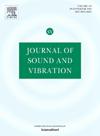Zero-stiffness in rolling-lobe air springs for passive, load adaptable and low-frequency vibration isolation
IF 4.3
2区 工程技术
Q1 ACOUSTICS
引用次数: 0
Abstract
Low-frequency vibration isolation is crucial for engineering structures and devices susceptible to low-frequency vibrations. Traditional linear isolators fail to provide effective low-frequency isolation without compromising static load capacity. At the same time, quasi-zero-stiffness designs struggle with load adaptability, maintaining zero-stiffness over a large displacement range, or require active components to achieve the former. Combining all of these features, this study investigates rolling-lobe air spring isolators as a passive vibration isolation alternative, aiming to achieve zero-stiffness across a wide displacement range under varying loads. To identify factors affecting vibration isolation performance in rolling-lobe isolators, this research examines various design parameters, including isolator geometry, internal pressure, external volume and membrane behavior. These parameters’ influence on the stiffness and damping characteristics is investigated through a rapid prototyping approach employing 3D-printing to fabricate and test 86 unique isolator configurations. The experimental data informs a predictive model based on a Duffing oscillator, which is then applied in single degree-of-freedom simulations to assess isolation efficiency across different loads and excitation levels. The simulation results demonstrate effective isolation from close to 2 Hz onwards for the most promising configuration. Key findings are that higher internal pressures, controlled membrane deformation, and the addition of external volumes greatly enhance isolation performance. These insights provide valuable guidelines for designing rolling-lobe isolators capable of achieving zero-stiffness under varying loads and excitation levels, making them suitable for applications demanding robust passive vibration isolation over a broad range of operating conditions.
用于被动、负载自适应和低频隔振的滚叶空气弹簧零刚度
低频隔振对于易受低频振动影响的工程结构和设备至关重要。传统的线性隔离器不能提供有效的低频隔离而不影响静态负载能力。与此同时,准零刚度设计与负载适应性相斗争,在大位移范围内保持零刚度,或者需要主动元件来实现前者。结合所有这些特点,本研究研究了滚动叶式空气弹簧隔振器作为被动隔振的替代方案,旨在在不同载荷下的大位移范围内实现零刚度。为了确定影响滚叶式隔振器隔振性能的因素,本研究考察了各种设计参数,包括隔振器的几何形状、内部压力、外部体积和膜性能。这些参数对刚度和阻尼特性的影响进行了研究,通过快速成型方法,利用3d打印制造和测试了86种独特的隔振结构。实验数据为基于Duffing振荡器的预测模型提供信息,然后将其应用于单自由度仿真,以评估不同负载和激励水平的隔离效率。仿真结果表明,对于最有希望的配置,在接近2hz的范围内可以有效隔离。主要发现是,较高的内压、可控的膜变形和外部体积的增加大大提高了隔离性能。这些见解为设计能够在不同负载和激励水平下实现零刚度的滚动瓣隔振器提供了有价值的指导,使其适用于在广泛的工作条件下要求强大的被动隔振的应用。
本文章由计算机程序翻译,如有差异,请以英文原文为准。
求助全文
约1分钟内获得全文
求助全文
来源期刊

Journal of Sound and Vibration
工程技术-工程:机械
CiteScore
9.10
自引率
10.60%
发文量
551
审稿时长
69 days
期刊介绍:
The Journal of Sound and Vibration (JSV) is an independent journal devoted to the prompt publication of original papers, both theoretical and experimental, that provide new information on any aspect of sound or vibration. There is an emphasis on fundamental work that has potential for practical application.
JSV was founded and operates on the premise that the subject of sound and vibration requires a journal that publishes papers of a high technical standard across the various subdisciplines, thus facilitating awareness of techniques and discoveries in one area that may be applicable in others.
 求助内容:
求助内容: 应助结果提醒方式:
应助结果提醒方式:


